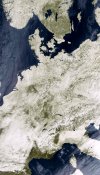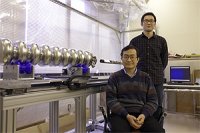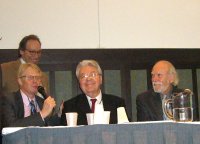Wise counsel for Europe

It is easy to get snowed under with information in Europe. An advisory board helps Director Brian Foster stay on top of things. (Image: ESA) |
Even – or especially ? – directors cannot have their eyes everywhere. They need to gather information and be able to judge things – but how do you do this on a continent where labs can be 3,000 kilometres apart, every country has different forms of governance, and science policy and funding agencies couldn’t be harder to grasp? Global Design Effort European Regional Director Brian Foster has found his own solution. If a reasonable number of high-level European physicists and lab directors come together in one place, he often calls for a meeting of his Advisory Group. One of these European Advisory Group meetings has just happened at DESY, slotted in right after the ICFA and ILCSC meetings, to minimise travel.
Read more...
-- Barbara Warmbein |
 |
|
|
 |
Upcoming meetings, conferences, workshops
 TILC08 TILC08
Joint ACFA Physics and Detector Workshop and (GDE meeting) on International Linear Collider
Sendai
3-6 March 2008
Positron Source Meeting
DESY Zeuthen, Germany
7-9 April 2008
Energy Polarization Workshop
DESY Zeuthen, Germany
9-11 April 2008
SiD Workshop
RAL
14-16 April 2008
Workshop on High energy photon collisions at the LHC
CERN, Geneva
21-25 April 2008
LoopFest VII
Radiative Corrections for the LHC and ILC
University at Buffalo, The State University of New York, Amherst, New York, USA
14-16 May 2008
ICFA NANOBEAM Workshop (NANOBEAM-08)
Announcement
Budker INP, Novosibirsk, Russia
25-30 May 2008
|
|
 = Collaboration-wide Meetings = Collaboration-wide Meetings
GDE Meetings calendar
View complete ILC calendar
|
|
|
 |
 |
|
|
 |
Looking inside

High-resolution surface inspection camera for superconducting cavities with Yoshihisa Iwashita (left) and Yujiro Tajima (right) from Kyoto university. |
At the ILC, roughly 16,000 superconducting RF cavities made of pure niobium will accelerate electrons and positrons to the high energy of 500 GeV. Each one-metre-long cavity consists of nine cells, polished to provide micrometre-level surface smoothness and absolutely no impurities. The inside of the cavities need to literally sparkle since any surface blemishes or dust could cause them to lose their superconductivity, making them unable to sustain the electric field needed to accelerate particles. ILC scientists around the world are devoted to trying to get a higher yield rate for producing good-quality cavities by improving surface treatment methods and inspection procedures. A group of scientists from Kyoto University and KEK jointly developed the novel inspection system to take a close look at the interior surface of the cavities, and produced remarkable results.
Read more...
-- Rika Takahashi |
 |
|
|
 |
From Cheshire News
19 February 2008
Laboratories future confirmed - despite jobs threat
DESPITE more than 350 jobs being under threat, the Science and Technology Facilities Council has confirmed its commitment to the future of Daresbury Laboratory.
Read more... |
|
From wired
19 February 2008
Physicist Neil Turok: Big Bang Wasn't the Beginning
For decades, physicists have accepted the notion that the universe started with the Big Bang, an explosive event at the literal beginning of time. Now, computational physicist Neil Turok is challenging that model -- and some scientists are taking him seriously.
Read more... |
|
From BBC Radio 4
18 February 2008
Today programme
Physicists meeting in Boston are grappling with the secrets of the Universe. (starts 9 minutes into the clip)
Read more... |
|
From Arizona Daily Star
17 February 2008
'08 may prove to be a watershed year in large-scale physics
... But Aymar and the other speakers at a lecture titled "Physics on a Grand Scale" proved that the future of all types of international endeavors in physics will excite more than just subatomic particles.
Read more... |
|
From ars technica
16 February 2008
AAAS: Large-scale collaborations in physics
... According to Dr. Barish, the LHC will lead the way and have large, broad reach, while the ILC will provide a second look with higher levels of precision.
Read more... |
|
|
 |
Contemplating large international collaborations

Lawrence Krauss (back), Norbert Holtkamp, Robert Aymar and Barry Barish during the AAAS session. |
The American Association for the Advancement of Science (AAAS) annual meeting took place from 14 to 18 February in Boston, US, under the theme "Science and Technology from a Global Perspective." The AAAS is the meeting ground for the broad range of sciences in the US, from biology to physics. This association also publishes the very famous weekly journal Science. In the spirit of the conference theme, Lawrence Krauss, Case Western Reserve University, and Maria Spiropulu, CERN, organised a very provocative and interesting special session entitled, "Large-Scale International Collaborations and the Future of Physics."
Read more...
-- Barry Barish
Director's Corner Archive |
 |
|
|
 |
Activate heat shield!

A four-unit string of TESLA-like cavities in cold mass assembly at KEK's superconducting test facility STF. The two-phase line has been welded and the subassembly is nearly ready for installation of the heat shields. (Credit: Nobu Toge)
|
Got a story?
Have you just reached a major milestone? Is there an interesting story from your lab? Do you have comments on today's issue of NewsLine, or the newsletter in general? Tell us at communicators@ linearcollider.org.
arXiv preprints
0802.2430
The Modeling of Time-Structured Multiturn Injection into Fermilab Main Injector (Microbunch Injection with Parasitic Longitudinal Painting)
0802.2209
Associated Photons and New Physics Signals at Linear Colliders
0802.2162
Probing two Universal Extra Dimensions at International Linear Collider
|
|

